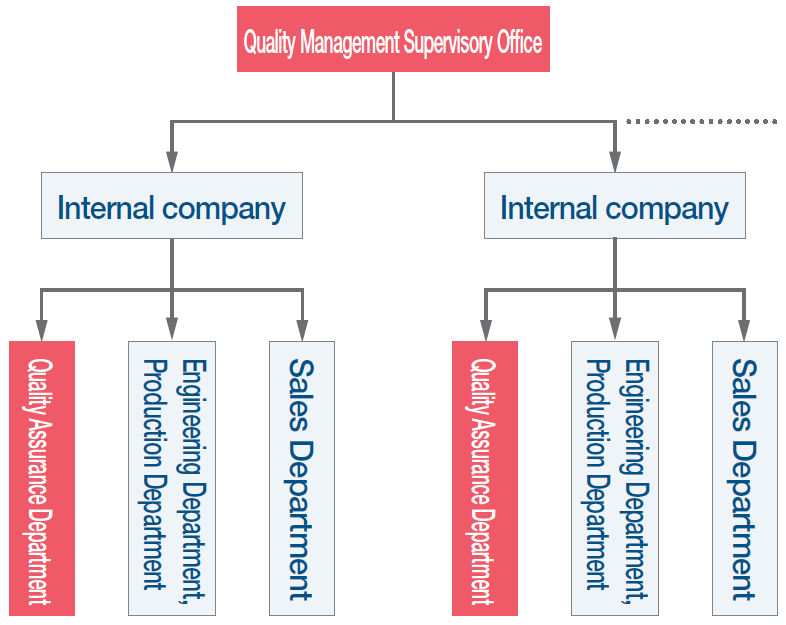Our Group’s basic philosophy regarding quality is to “Prioritize quality in
our products and earn the trust of customers.” This philosophy is embodied by
and integrated on an organizational level through the Group Code of Conduct
and the Code of Ethical Conduct, among others.
In order to put our basic philosophy into practice, each internal company
has formulated its own quality policy and is working actively to acquire
and update certifications, including ISO 9001 or JIS Q 9100, and making
continuous improvements of quality management systems.
| ISO9001 |
Marine Systems Company
Measurement Systems Company
Fluid Power & Control Systems Company
Inspection Systems Company
Communication & Control Systems Company |
| JIS Q 9100 |
Electronics Systems Company |
We have established a Quality Management Supervisory Office to deal with
company-wide issues relating to quality under our Headquarters’
administrative divisions.
The Quality Management Supervisory Office
engages in the cross-organizational management and supervision of quality
to ensure that our Group’s products remain above a certain level of
quality. The office also engages in activities to prevent risks to quality
before they manifest. More specifically, in addition to maintaining and
managing the Technical Production Regulations, which are company- wide
rules regarding the quality of our products, the Quality Management
Supervisory Office complements the independent quality management efforts
of individual quality assurance departments by conducting inspection
quality audits of each internal company and subsidiary.
Within each
internal company, the Quality Assurance Department is established
independently from the Sales, Engineering, and Production departments,
providing direction and guidance in the contracting, design and
development, purchasing, production, inspection, and service stages of the
work process. In addition, we have established a framework of internal
company rules, allowing each internal company, with their varying
characteristics, to draw up its own operational rules as long as they do
not violate the Technical Production Rules.

The Quality Subcommittee was established as a forum for sharing information and resolving cross-organizational quality
issues within the Company. It meets under the jurisdiction of the Chief Quality Officer, with the quality managers of each
internal company and subsidiary as members. It is held four times a year by the Quality Management Supervisory
Office to identify Company-wide problems and future challenges relating to quality, and to formulate measures to
resolve them. In the event that concerns emerge regarding quality at an internal company or subsidiary, a report is
made to the Chief of Quality at a Quality Subcommittee meeting. If the Chief of Quality deems it necessary, the
Chief provides instructions to correct the issue and conveys information about the issue to the senior management at the Management Conference, etc.
The Quality Management Supervisory Office conducts inspection quality audits
on each internal company and subsidiary. In order to ensure audit
effectiveness and improve the quality management capabilities of our internal
companies and subsidiaries, audit methods and scope are revised annually.
Aiming to further improve product quality, the Quality Subcommittee has worked
to build a defect database to share throughout the Group information on
defects as well as peripheral knowledge, which had previously been accumulated
on an individual basis by each internal company and subsidiary.
In fiscal 2023, analysis result reports of defects for the past 11 years managed by the Testing and Analysis
Team (belonging to the Engineering & Products Service Office) were compiled into a database. We will continue to update the database sequentially.
Internal quality audits are one means we use to maintain and strengthen
quality management systems (QMS*1), and we conduct internal auditor education in
order to maintain and enhance the capabilities of our lead and regular
auditors. Further, each of our internal companies holds meetings regarding
quality (QC*2 meetings, quality committees, etc.) to report defects
and share solutions.
Hierarchy-specific education on quality assurance and QMS is provided when employees join the company
and when they are promoted to higher positions. An example of an everyday awareness-raising activity is our
holding of human error debriefings, whose aim is the prevention of defects. In addition, we have established
a quality enhancement month during which we solicit quality-related slogans from employees and post the
best entries in the factory and conduct in each workplace circle activities (improvement activities) that focus on the
theme of “improving QCD*3” to maintain and strengthen awareness of quality.
We also encourage employees to acquire QC certification as a form of self-development. Instructors
provide supplementary education to those who wish to acquire certification, producing many employees who have acquired the certification.
The scope of quality control has been expanded to the entire Hydraulics and Pneumatics business segment, and
in order to improve quality control through the sharing of information, quality meetings are held in cooperation
with our subsidiaries TOKYO KEIKI POWER SYSTEMS INC. and TOKYO KEIKI PRECISION TECHNOLOGY CO.,
LTD. (Vietnam), and affiliate TOKIMEC KOREA POWER CONTROL CO., LTD. (Korea).
In addition, for specially controlled products, for which inspection details are individually agreed upon with the
customer, we have established a separate QMS and strengthened our inspection quality system by providing
professional ethics education, inspector training and appointment/registration, and conducting unannounced
audits of the relevant divisions.
Furthermore, in addition to the circle activities for improving productivity and work efficiency that have
been carried out up until now, we are also focusing on maintaining and improving quality and human resource development.
In order for our employees to learn quality control
methods and improve their awareness of quality, we
encourage them to obtain QC certifications and hold
training sessions for doing so.
Participation in training sessions for obtaining QC certifications covers the Marine Systems Company, the
Electronic Equipment Department of the Fluid Power & Control Systems Company, the Production Department
of the Inspection Systems Company, and TOKYO KEIKI TECHNOPORT INC. The Yaita Plant as a whole promotes activities to raise awareness.
*1 QMS: Quality Management System
*2 QC: Quality Control
*3 QCD: Quality, Cost, Delivery